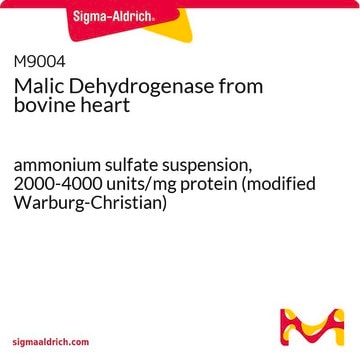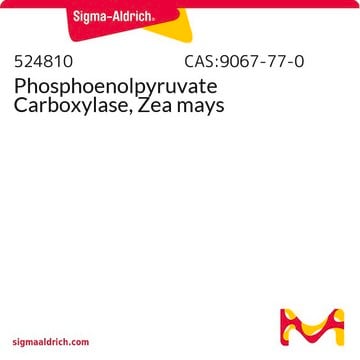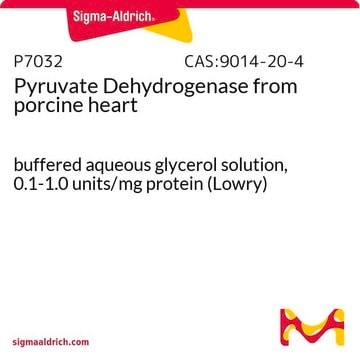C1744
Phosphoenolpyruvate carboxylase microbial
≥5.0 unit/mg solid
Synonym(s):
PEPC
Sign Into View Organizational & Contract Pricing
All Photos(1)
About This Item
Recommended Products
form
lyophilized powder
specific activity
≥5.0 unit/mg solid
mol wt
~390 kDa
storage temp.
−20°C
Application
Phosphoenolpyruvate carboxylase (PEPC) is an enzyme useful for enzymatic determination of carbon dioxide when coupled with malate dehydrogenase in clinical analysis. PEPC is also used to study carbon assimilation, post-translational regulation and allosteric regulation in various plants .
Biochem/physiol Actions
Phosphoenolpyruvate carboxylase (PEPC) catalyzes the addition of bicarbonate to phosphoenolpyruvate (PEP) to form the four-carbon compound oxaloacetate and inorganic phosphate . In CAM and C4 plants, PEPC catalyzes the photosynthetic assimilation of CO2 into an organic acid. PEPC is activated by glucose-6-phosphate and is inhibited by malate and aspartate. PEPC comprises about 0.5-2% of the soluble protein in alfalfa and soybean nodules .
Unit Definition
One unit causes the oxidation of one micromole of NADH per minute at pH 8.0 at 30°C.
Physical form
White amorphous lyophilized powder containing BSA and sugar alchohols as stabilizers.
Signal Word
Danger
Hazard Statements
Precautionary Statements
Hazard Classifications
Resp. Sens. 1
Storage Class Code
11 - Combustible Solids
WGK
WGK 1
Flash Point(F)
Not applicable
Flash Point(C)
Not applicable
Certificates of Analysis (COA)
Search for Certificates of Analysis (COA) by entering the products Lot/Batch Number. Lot and Batch Numbers can be found on a product’s label following the words ‘Lot’ or ‘Batch’.
Already Own This Product?
Find documentation for the products that you have recently purchased in the Document Library.
Customers Also Viewed
Mika Nomura et al.
Plant & cell physiology, 47(5), 613-621 (2006-03-10)
Phosphoenolpyruvate carboxylase (PEPC, EC 4.1.1.31) is believed to play a significant role in supporting nitrogen fixation via anaplerotic CO2 fixation for recycling carbon in nodules. Using the antisense technique, we decreased the expression levels of the nodule-enhanced PEPC gene (Ljpepc1)
Multiple origins of allopolyploid wheatgrass Elymus caninus revealed by RPB2, PepC and TrnD/T genes.
Chi Yan et al.
Molecular phylogenetics and evolution, 64(3), 441-451 (2012-05-24)
We examined evolutionary mechanisms in the tetraploid Elymus caninus by comparing the phylogenetic relationships of 21 accessions suggested by sequence data from two single copy nuclear genes, the largest subunit of RNA polymerase II (RPB2) and phosphoenolpyruvate carboxylase (pepC), and
Jianfang Xu et al.
PloS one, 7(5), e37438-e37438 (2012-05-23)
Ulva prolifera, a typical green-tide-forming alga, can accumulate a large biomass in a relatively short time period, suggesting that photosynthesis in this organism, particularly its carbon fixation pathway, must be very efficient. Green algae are known to generally perform C₃
Ewa Gajewska et al.
Journal of plant physiology, 170(4), 369-377 (2013-02-05)
In this study, we analyzed the toxic effect of Ni during the development of wheat shoots. Typical developmental alterations in carbon metabolism-related parameters reflecting changes associated with the transition of the seedlings from heterotrophic to autotrophic metabolism were observed in
Patrizia De Nisi et al.
Plant physiology and biochemistry : PPB, 57, 168-174 (2012-06-19)
The regulation exerted by the Fe status in the plant on Fe deficiency responses was investigated in Cucumis sativus L. roots at both biochemical and molecular levels. Besides the two activities strictly correlated with Fe deficiency response, those of the
Our team of scientists has experience in all areas of research including Life Science, Material Science, Chemical Synthesis, Chromatography, Analytical and many others.
Contact Technical Service










